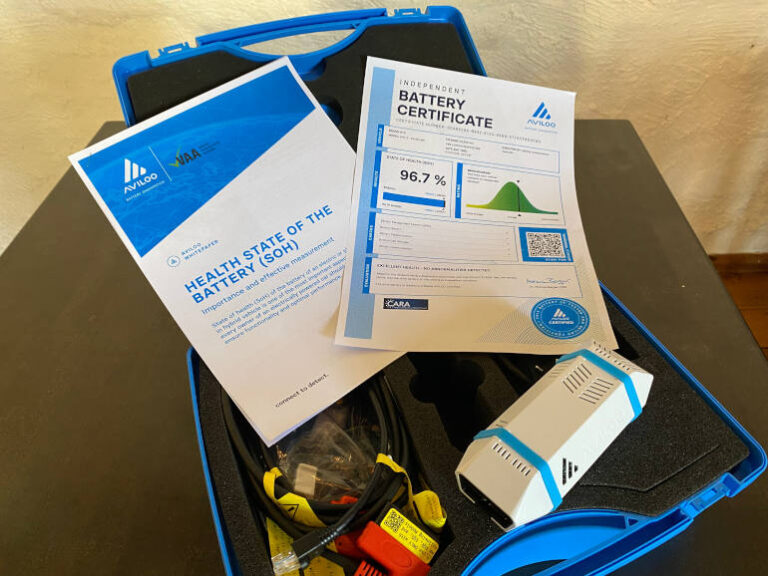Autorola Australia is rolling out battery health testing for electric vehicles (EVs), providing fleets and used vehicle buyers with the crucial insight needed to boost confidence in the second-hand EV market. According to Philip Browne, Managing Director at Autorola Australia, the initiative is designed to make the used EV market more transparent by accurately determining the ‘State of Health’ (SOH) of an EV battery.
“In partnership with Aviloo, we are offering our customers a free trial battery test,” Browne explained. “This allows them to see firsthand how the technology works and understand the true condition of the battery. What we’re finding in the market is that EV batteries are holding up extremely well—much better than many expected.”
The SOH test provides a detailed report on a battery’s remaining performance, based on data from the vehicle’s Battery Management System (BMS), including cell voltage, temperature data, battery capacity, and real-world performance benchmarking. It’s an innovation Browne says is long overdue in Australia.
“This kind of testing is much more established in Europe. There, the used car market has embraced EVs much more quickly. Battery testing is not only helping sellers justify better resale values, but also giving buyers the confidence they need to make the switch.”
Rewriting the EV Resale Narrative
Browne is under no illusions about the current challenges facing used EV sales in Australia. Despite positive test results, many dealers remain hesitant.
“There’s still a fear among dealers,” he said. “That fear stems partly from the heavy discounting on new EVs over the past few years. It makes it difficult to sell used EVs when a brand-new model can be bought at a steep discount. But we’re working hard to change that perception.”
According to Browne, providing reliable, independent battery health reports is a critical part of that shift—especially for fleet owners and novated lease providers, where resale value directly impacts whole-of-life cost.
“With battery testing, you eliminate the guesswork. You now know the true condition of the battery, not just the number of kilometres on the odometer or the age of the vehicle. That’s a level of transparency we’ve never had before in vehicle resale.”
Lessons from Europe and the Rise of the Second Owner
European markets have demonstrated that robust battery health testing supports the entire vehicle lifecycle—not just for the first owner.
“If you look after the second owner, the first owner is looked after too,” said Browne. “Right now, sales incentives only benefit the first owner. But if governments introduced ongoing benefits—like free parking, toll relief, or lower rego for second-hand EVs—it would support the used EV market and improve whole-of-life cost calculations for fleets.”
This second-owner value is increasingly important for fleet managers weighing up electric options. While lower running costs for EVs are well-documented, the lower resale values have hurt EVs when compared to popular hybrids like the Corolla or RAV4.
“Early indications show EVs still cost more over their lifetime than a hybrid Corolla or RAV,” Browne admitted. “Not because they’re expensive to run—they’re not—but because resale is still soft. That’s what we’re trying to change.”
Data-Backed Insights for Smarter Decisions
Autorola’s partnership with Aviloo taps into a global database of battery performance. Vehicles are benchmarked against similar makes and models across international markets, offering a richer picture of battery condition than a local road test could provide.
“This benchmarking is a very powerful tool,” said Browne. “It’s not just a state of health score. You can see if the car’s battery is performing above or below average, and you can detect early warning signs of excessive fast charging, overcharging, or aggressive driving.”
He noted that battery degradation is more closely tied to driver behaviour and charging patterns than just kilometres alone. One EV tested had logged over 300,000 kilometres and still showed a healthy battery thanks to careful use.
“We had a BYD come through recently that had done over 46,000 kilometres, and it tested above average,” said Browne. “We also found a Mercedes with below-average battery health—likely due to repeated fast charging and poor charging habits. These are the kind of insights we just haven’t had until now.”
EVs Ready to Go the Distance
Fleet Managers at the recent AfMA conference showed strong interest in the service, particularly those starting to cycle their first electric novated lease vehicles.
“Many fleet teams are planning to run their EVs longer than they would an ICE vehicle, partly because they’re finding the batteries are in better shape than expected,” said Browne. “Battery testing gives them the evidence they need to justify those decisions and confidently extend vehicle lifecycles.”
For high-use applications like taxis and ride-share, battery longevity is also proving better than anticipated.
“I was in Europe 18 months ago and took a Tesla taxi that had done more than 300,000 kilometres. The battery was still performing well. These are the stories—and the data—that will change the mindset here in Australia.”
Fit-for-Purpose and Fit for the Future
Browne believes that battery testing should become a standard part of EV ownership, whether it’s for fleet procurement, used vehicle sales, or even warranty claims.
“We’re seeing testing being used in Europe to verify underperforming vehicles. Just like with ICE vehicles, not every EV comes off the production line perfect. Testing helps identify faults early, and that’s critical for consumer confidence.”
Ultimately, he says, the transition to electric is well underway, and the market needs tools like SOH testing to support it.
“Battery testing is the equivalent of a compression test or oil analysis for an ICE vehicle. Except it’s faster, more accurate, and tells you exactly what you need to know.”
As for Autorola’s next step?
“We’re offering this service to fleets now, and we want more of them to take us up on the offer. It’s an investment in protecting resale, reducing risk, and building trust in a second-hand EV market that has huge potential.”






